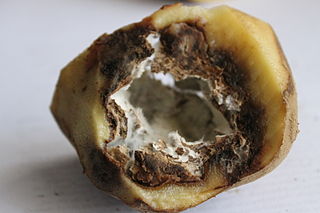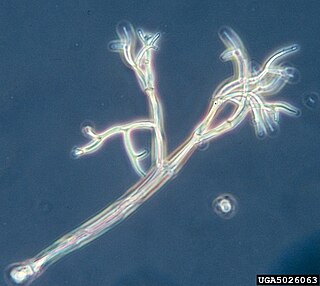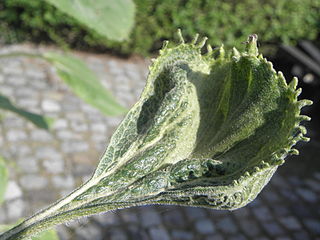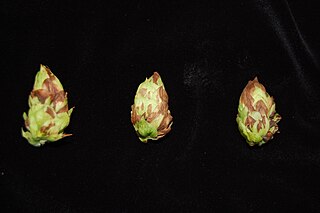
Downy mildew refers to any of several types of oomycete microbes that are obligate parasites of plants. Downy mildews exclusively belong to the Peronosporaceae family. In commercial agriculture, they are a particular problem for growers of crucifers, grapes and vegetables that grow on vines. The prime example is Peronospora farinosa featured in NCBI-Taxonomy and HYP3. This pathogen does not produce survival structures in the northern states of the United States, and overwinters as live mildew colonies in Gulf Coast states. It progresses northward with cucurbit production each spring. Yield loss associated with downy mildew is most likely related to soft rots that occur after plant canopies collapse and sunburn occurs on fruit. Cucurbit downy mildew only affects leaves of cucurbit plants.

Impatiens irvingii is a species of flowering plant in the family Balsaminaceae. It is native to tropical Africa.

Peronosporaceae are a family of water moulds that contains 21 genera, comprising more than 600 species. Most of them are called downy mildews.

Hyaloperonospora brassicae, in the family Peronosporaceae, is a plant pathogen. It causes downy mildew of species of Brassica, Raphanus, Sinapis and probably other genera within the Brassicaceae. In the past, the cause of downy mildew in any plant in the family Brassicaceae was considered to be a single species Peronospora parasitica. However, this has recently been shown to be a complex of species with narrower host ranges, now classified in the genus Hyaloperonospora, for example Hyaloperonospora parasitica on the weed Capsella bursa-pastoris. From the perspective of plant pathology, Hyaloperonospora brassicae is now the name of the most important pathogen in this complex, attacking the major agricultural and horticultural Brassica species. Other significant Brassicaceous hosts are attacked by different species in the complex, e.g. horseradish by Hyaloperonospora cochleariae, wallflower by Hyaloperonospora cheiranthi.

Hyaloperonospora parasitica is an oomycete from the family Peronosporaceae. It has been considered for a long time to cause downy mildew of a variety of species within the Brassicaceae, on which the disease can cause economically important damage by killing seedlings or affecting the quality of produce intended for freezing. Hyaloperonospora parasitica causes downy mildew on a wide range of many different plants. It belongs to the Kingdom Chromista, the phylum Oomycota, and the family Peronosporaceae. The former name for H. parasitica was Peronospora parasitica until it was reclassified and put in the genus Hyaloperonospora. It is an especially vicious disease on crops of the family Brassicaceae. It is most famous for being a model pathogen of Arabidopsis thaliana which is a model organism used for experimental purposes. Accordingly, the former Hyaloperonospora parasitica has been split into a large number of species. For instance, the taxonomically correct name of the parasite of the well-known model organism Arabidopsis thaliana is Hyaloperonospora arabidopsidis, not H. parasitica, whereas the pathogen of Brassica has to be called Hyaloperonospora brassicae.

Peronospora sparsa is an oomycete plant pathogen that causes downy mildew in berry producing plants; especially in the genus's Rubus and Rosa. Downy mildew plant pathogens are often host specific and cause problems in cloudberries, blackberries, boysenberries, strawberries, and arctic bramble. Since they are host specific, Peronospora sparsa will not cause downy mildew in grapes because a different plant pathogen causes downy mildew in grapes; Plasmopara viticola. Although it depends on the cultivar, symptoms do not normally start until later stages of disease and can look different on different plants. The most common symptoms include red lesions in the veins of leaves, with dry and deformed berries.
Sclerophthora macrospora is a protist plant pathogen of the class Oomycota. It causes downy mildew on a vast number of cereal crops including oats, rice, maize, and wheat as well as varieties of turf grass. The common names of the diseases associated with Sclerophthora macrospora include "crazy top disease" on maize and yellow tuft disease on turf grass. The disease is present all over the world, but it is especially persistent in Europe.

Bremia lactucae is a plant pathogen. This microorganism causes a disease of lettuce denominated as downy mildew. Some other strains can be found on 36 genera of Asteraceae including Senecio and Sonchus. Experiments using sporangia from hosts do not infect lettuce and it is concluded that the fungus exists as a quantity of host-specific strains. Wild species, such as Lactuca serriola, or varieties of Lactuca can hold strains that infect lettuce, but these pathogens are not sufficiently common to seriously infect the plant.

Peronospora farinosa is a species name that has been widely applied to downy mildew on leaves of wild and cultivated Amaranthaceae: Amaranthus, Atriplex, Bassia, Beta, Chenopodium, Halimione, Salsola, Spinacia, etc. However, the species name has been taxonomically rejected as the original description contained reference to multiple species and could not unequivocally be attributed to a species of Peronospora. In the past, some of the species on important crop plants have been given names as formae speciales, notably f.sp. betae on sugar beet and f.sp. spinaciae on spinach. However, phylogentic reconstructions have revealed that these "forms" of Peronospora on different genera and their subdivisions, are distinct species, most of which already have previously published scientific names. Such host specialization possibly also exists with respect to the various wild amaranthaceous species given as hosts of P. farinosa.

Plasmopara halstedii is a plant pathogen infecting sunflowers. The species is one of many pathogens commonly referred to as downy mildew. P. halstedii originated in North America.
Plasmopara obducens is a species of oomycete that causes Impatiens downy mildew. It was first described on Impatiens noli-tangere in Germany in 1877. Plasmopara obducens is known from native species of Impatiens since the 1800s, but outbreaks on cultivated varieties of Impatiens walleriana started in 2003 in the United Kingdom and in 2004 in the United States. The outbreak spread worldwide by 2016.

Plasmopara viticola, the causal agent of grapevine downy mildew, is a heterothallic oomycete that overwinters as oospores in leaf litter and soil. In the spring, oospores germinate to produce macrosporangia, which under wet condition release zoospores. Zoospores are splashed by rain into the canopy, where they swim to and infect through stomata. After 7–10 days, yellow lesions appear on foliage. During favorable weather the lesions sporulate and new secondary infections occur.
Pseudoperonospora cannabina is a plant pathogen that causes downy mildew, which is a fungal-like disease caused by an oomycete.

Pseudoperonospora humuli is a plant pathogen that causes downy mildew on hops.

Melothria scabra, commonly known as the cucamelon, Mexican miniature watermelon, Mexican sour cucumber, Mexican sour gherkin, mouse melon, or pepquinos, is a species of flowering plant in the cucurbit family grown for its edible fruit. Its native range spans Mexico to Venezuela. Cucumis melo Agrestis and Cucumis callosus is cultivated as Chibber Fruit or Kachri in South Asia and can also grow as weed. Fruits are about the size of grapes and taste like cucumbers with a tinge of sourness. It may have been eaten by indigenous peoples before the European colonization of the Americas began.

Pseudoperonospora cubensis is a species of water mould known for causing downy mildew on cucurbits such as cantaloupe, cucumber, pumpkin, squash and watermelon. This water mould is an important pathogen of all these crops, especially in areas with high humidity and rainfall, such as the eastern United States. In most years the disease is an annual, late-season problem on squash and pumpkin in the eastern and central United States, however, since 2004 it has become one of the most important diseases in cucumber production. Considered a highly destructive foliar disease of cucurbits, successful breeding in the mid-twentieth century provided adequate control of downy mildew in cucumber without the use of fungicides. The resurgence in virulence has caused growers great concern and substantial economic losses, while downy mildew in other cucurbit crops continues to be a yearly hindrance.

Peronospora is a genus of oomycetes that are obligate plant pathogens of many eudicots. Most species in this group produce a downy mildew disease, which can cause severe damage to many different cultivated crops, as well as wild and ornamental plants. There are 19 genera that produce downy mildew, and Peronospora has been placed alongside Pseudoperonospora in the group of downy mildews with coloured conidia. Peronospora has far more species than any other genus of the downy mildews. However, many species have been moved from this genus to be reclassified to other or new genera. Among these was the most famous Peronospora species, formerly known as Peronospora parasitica, and now known as Hyaloperonospora parasitica. Now, the Peronospora species of most importance is likely the Peronospora tabacina. Peronospora tabacina causes blue mold on tobacco plants and can severely reduce yields of this economically important crop to the point where it has been classified as a bioweapon.

Peronospora destructor is a plant pathogen. It causes downy mildew on leaves of cultivated and wild Allium. Allium cepa is most often affected, while Allium schoenoprasum (chives) and Allium porrum (leek) are only occasionally affected.
Commonly known as Philippine downy mildew, this disease is caused by the species Peronosclerospora philippinensis of the fungal-like protist class Oomycetes, which also has members such as water molds and Phytophthora infestans, which caused the potato blight that led to the Great Irish famine.

Ovidiu Constantinescu was a Romanian mycologist known for his work on the taxonomy of the Peronosporales.















